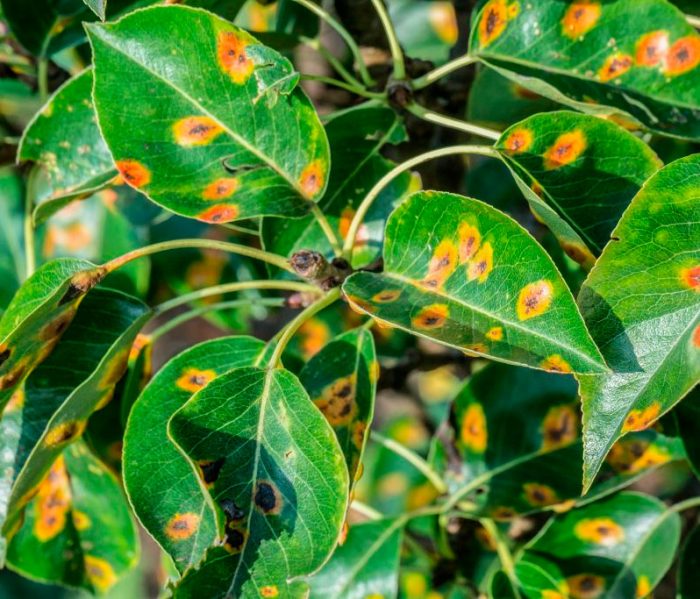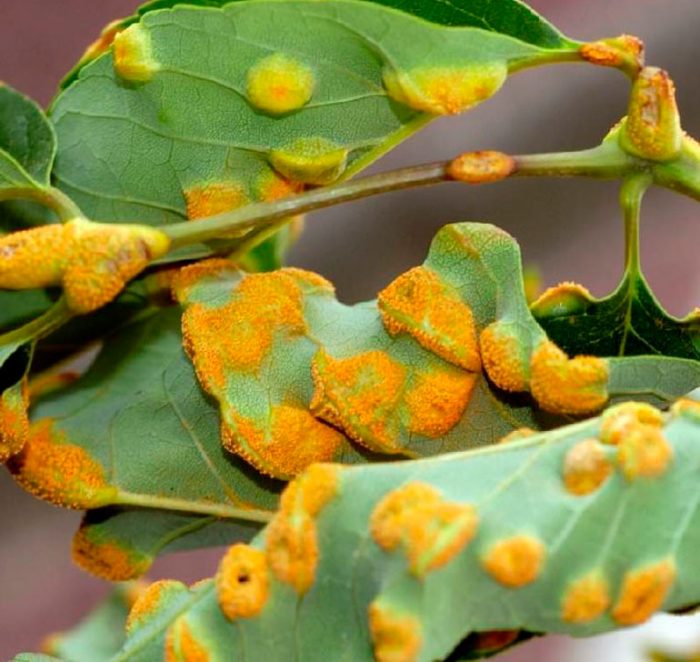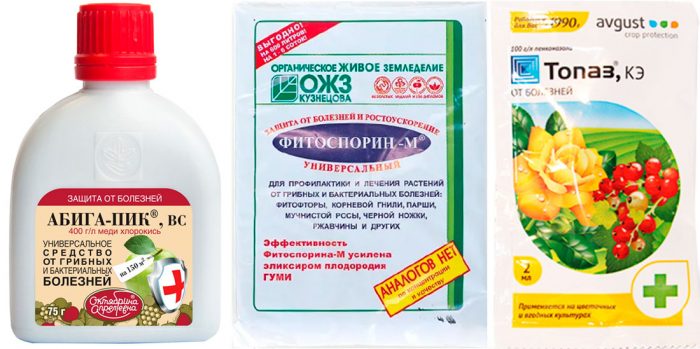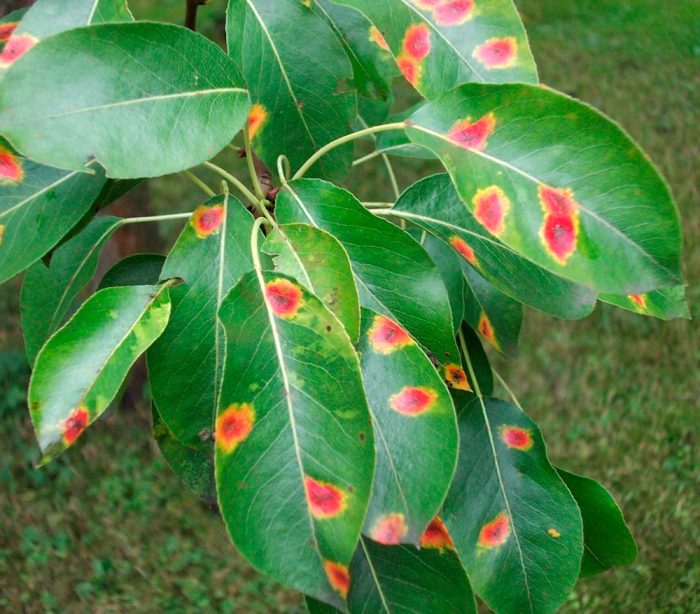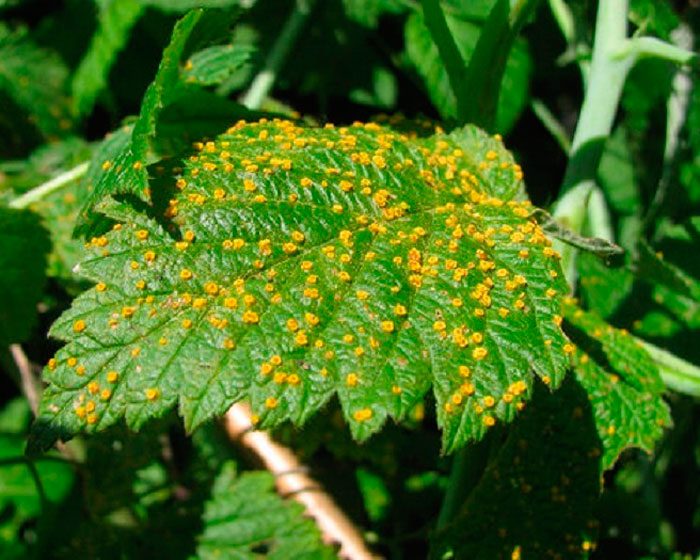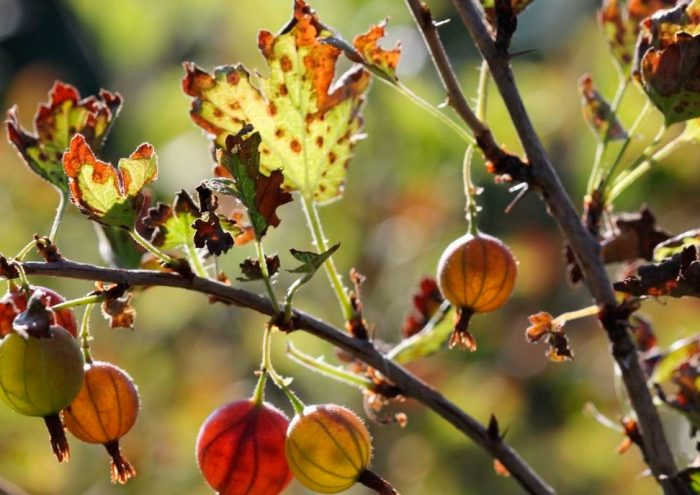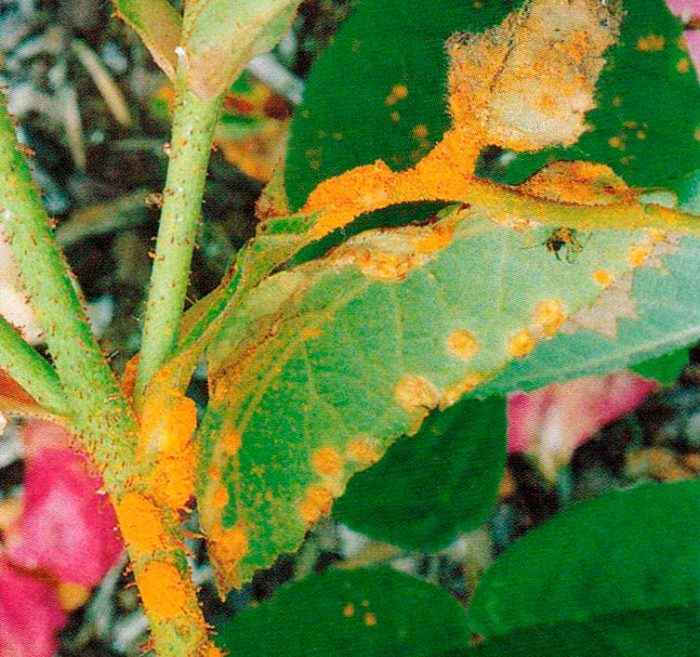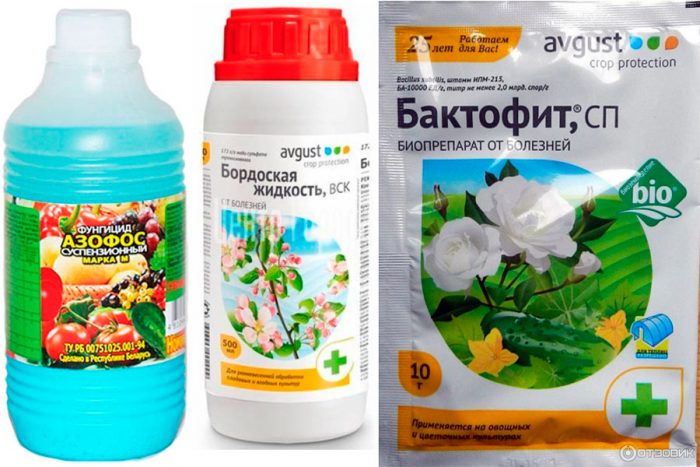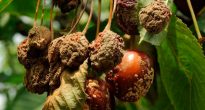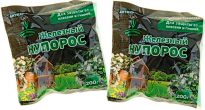Rust is a common plant disease that can be caused by various members of the subclass Heterobasidiomycetes. The main symptom of this disease is the appearance on the surface of the aboveground parts of the plant of various sizes and shapes of pustules, which contain spores of a rusty hue. The development of some pathogens occurs only on one host plant, and therefore they are called single-farm. However, the greatest danger is posed by multi-economic rust pathogens, the development of which can occur on several plants.
Content
Rust features
If the plant is affected by rust, then the main sign by which this can be determined is convex dirty-red spots and stripes that form on the seamy surface of the leaf plates, and in some cases on the petioles. These marks are projected onto the upper surface of the leaves with yellow spots. Over time, velvety pads appear on the seamy surface of the foliage in the area of these spots, inside which there are spores of the fungus. The disease contributes to the development of increased evaporation of moisture (transpiration), due to which the leaves dry out and fly around. Also, in a diseased culture, there is a deterioration in photosynthesis, metabolic disorders, and also a cessation or decrease in the formation of increments. If the plant is very badly affected by rust, then other aerial parts of it may be damaged. In addition, the disease contributes to a decrease in yield, and also has an extremely negative effect on the quality of fruits and frost resistance of the crop. Rust-diseased cereals lose all their baking properties. If a diseased plant is not treated, it will die.
The causative agents of the disease are carried from plant to plant by insects and wind. The disease poses a danger to spicy, flower, cereal, vegetable, fruit and berry crops. The following plants are affected by it: pear and apple trees, gooseberries, currants, honeysuckle, grapes, raspberries, onions, garlic, beets, carrots, cucumbers, as well as garden and indoor flowers. Rust also affects cereals: wheat, barley, rye, oats and millet.
How to deal with rust
As soon as the first symptoms of rust on the plant are found, it is necessary to start fighting it.At an early stage of the development of the disease, you just need to cut off all diseased leaf plates. If the disease is already neglected, and pustules have multiplied on the plant, then it will be possible to cure it only with the use of special means designed to combat fungal diseases. The following chemicals cope best with this disease: Abiga-Peak, Fitosporin, Topaz, Baktofit or Bordeaux liquid solution (1%). However, to get rid of rust, not one, but at least two treatments will be required, and re-spraying is carried out after 7-15 days. A sick bush is treated on a calm, warm and cloudy day, but there should be no rain. If it rains on this day or the next day, the plant will have to be sprayed again.
In order for the fight against rust to be successful, it is necessary to find out exactly how the plant was affected. Experts say that most often pathogenic fungi get on crops from conifers growing nearby. It was also noticed that indoor plants were most often affected by this disease after the New Year holidays. The fact is that conifers are very often intermediate hosts of pathogens of such a fungal disease, but they themselves are not affected by it, but at the same time contribute to its spread to other crops.
Prevention measures
If the plant is not yet affected by rust, then in order to avoid this, it will be necessary to carry out all the necessary preventive measures in a timely manner. Sometimes, thanks to just such preventive measures, it is possible to protect not only orchards and vegetable gardens, but also plantations, as well as fields from rust infection and death. Basic preventive measures:
- After the crop is harvested from the site, all plant residues must be removed from it.
- In the fall, it is recommended to plow the site or you can deeply dig it.
- It is necessary to adhere to the agrotechnical rules of culture, namely: it is necessary to sow the crop within the established time frame, feed it and water it correctly, etc. Thanks to good and proper care, the plants will be strong and more resistant to any diseases, including rust.
- Seed material needs mandatory pre-sowing preparation.
- Process crops regularly for prophylaxis, for this you can use fungicidal preparations or herbal solutions.
- For cultivation, it is worth choosing hybrids and varieties that are highly resistant to disease.
Treating rust on trees
Rust of apple and pear
Almost all fruit trees are susceptible to rust damage, but pears and apple trees suffer most from this disease. If you carefully examine the front surface of the foliage of the affected plant, then you can see brown-red oval specks on it. Moreover, over time, these spots increase. Treatment of the plant should be started immediately after the first symptoms of the disease are detected. Otherwise, by the middle of the summer period, on the seamy surface of the foliage, you will find very quickly growing bulging growths. Then the leaves begin to fly around, as a result of which the plant weakens and becomes less frost-resistant, and also due to rust, the gardener may lose part of the crop.
The first step is to cut out all diseased parts of the tree, namely branches, fruits, foliage and shoots. Moreover, when cutting off the affected branches, it is imperative to capture from 5 to 10 centimeters of healthy tissue, and the places of the cuts are treated with garden varnish. After that, the culture is treated with a solution of a copper-containing fungicide preparation, for example: Poliram, Kuproksat, Strobi, Abiga-Peak, Cumulus, Vectra, Bordeaux mixture (1%) or others. Both surfaces of all leaf plates are abundantly moistened with a healing solution.Re-spraying is carried out after 7-15 days.
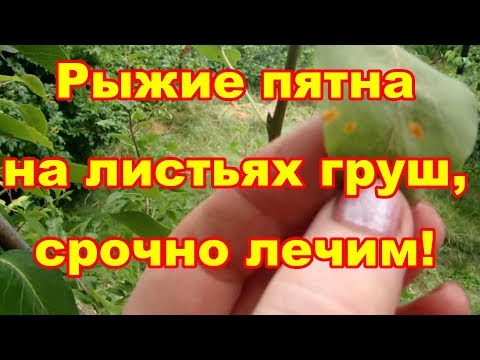

Watch this video on YouTube
Other trees
If other fruit trees are affected by rust, then in order to cure them, use the same methods and preparations as in the case of an apple or a pear. But remember that diseased plants are sprayed with a fungicide solution, which is capable of harming both the plant itself and the person, because the harmful substances contained in it can accumulate in the fruits. But for spraying in order to prevent the disease, solutions are used, the concentration of which is 3 or 4 times weaker than the medicinal mixture. This means that they are practically harmless to both culture and people, but at the same time they are able to protect the plant from disease.
It is best to carry out preventive spraying in early spring before the buds swell, for this use a solution of Bordeaux liquid (3%). Next, the tree is sprayed in the period between the extension of the buds and the swelling of the buds, and a solution of a contact fungicidal agent is used for this. For example, you can use Penkoceb (for 1 liter of water 2 grams), Azofos (for 1 liter of water 10 grams) or Medex (for 1 liter of water 10 grams). Before the plant blooms and immediately after flowering, it is treated with a solution of Skor or Strobi (for a bucket of water from 1.5 to 2 milligrams of the drug). Also, experts advise to spray the trees one more time with one of the listed agents during the growth of the fruit. Such spraying will help protect trees from both rust and other fungal diseases.
Bushes rust
Raspberry rust
On raspberries, the fungus Phragmidium rubi-idaei is considered to be the causative agent of rust, which is most dangerous in high humidity. In the affected bush, on the front surface of the foliage, as well as on the petioles and median veins, small, slightly convex, rounded pads of a pale red color appear. On the surface of annual stems, the formation of gray ulcers with a pale red border is observed, as the disease progresses, they become larger and connect with each other, forming longitudinally located cracks. If the weather conditions are favorable for the development of the fungus, then several generations of spores may appear during the summer period. Rust develops most actively at high air humidity and precipitation. The foliage that is very strongly affected begins to dry, and the resistance of the shrub to frost decreases.
In order to prevent rust, after the entire crop has been harvested, clear the area near the bushes from loose leaves, and also cut and destroy all diseased branches and stems. Then loosen the soil near the plants. In early spring, cover the surface of the soil in the raspberry bush with manure, as it helps destroy rust spores. And even before the sap flow begins, the raspberries are sprayed with a solution of Bordeaux mixture (3%). Shortly before flowering, all bushes are treated with any suitable fungicidal preparation or Bordeaux mixture solution (1%).
Rust of currant and gooseberry
On gooseberries and currants, two types of rust can develop:
- goblet - caused by the fungus Puccinia ribesicaricis;
- columnar - begins to develop due to the fungus Cronartium ribicola.
Most often, shrubs are infected with goblet rust from sedge foliage. And the main distributors of columnar rust are cedar, Weymouth pine or cedar pine. These two types of rust have very similar symptoms. However, currants are most often affected by columnar rust, not gooseberries.
Immediately after detecting signs of the disease, cut off all diseased buds, leaf plates, stems and flowers, after which the plant is sprayed with a fungicide solution containing copper, which is prepared according to the instructions (see the package).The second time the plant is sprayed with the same product after 1–2 weeks. In order to prevent, gooseberries and currants are processed in early spring, when the bushes will fade, and after harvesting. This will protect the plants from being affected by such a dangerous fungal disease.
Rust of flowers and plants
Composite cultures
All Compositae crops are susceptible to rust damage, for example: asters, chrysanthemums, dahlias, daisies, marigolds, marigolds, zinnias and many others. In this case, the causative agent of the disease is the fungus Coleosporium solidaginis. In a sick bush, pustules are formed on the seamy surface of the foliage, in which there are spores of the fungus. Over time, drying and dying off of the affected stems and leaf plates is observed.
To fight the disease on plants belonging to the Asteraceae family, it is necessary to use the same methods and means as in the case of fruit and berry crops, namely: adhere to the agrotechnical rules of culture, take good care of flowers and do not forget about preventive spraying. Fungicides are used to treat affected bushes.
Clove crops
In patients with clove rust, in the first half of the summer period, brown pustules are formed, covered by the epidermis, and they crack as they mature. In the affected bushes, there is a lag in development and growth, and their foliage dries up and flies around. In the autumn, pustules of a dark brown hue can be found on the affected leaf plates, which have passed into the winter stage of the fungus.
Bulbous plants
Hyacinths, tulips and lilies are also attacked by rust, in which case the fungus Uromyces scillarum is the causative agent. In diseased bushes, discolored spots form on the foliage, reaching up to 0.2 cm in diameter and turning yellow over time. The formation of brown spores occurs under the epidermis and on the inner scales of the bulbs. The bush looks lethargic, and over time, diseased foliage begins to fly around. The disease also negatively affects the quality of flowering.
Cruciferous crops
Cruciferous plants are attacked by white rust caused by the fungus Albugo candida. In a diseased plant, all its aboveground parts are affected. The disease develops most actively in the first months of the growing season, at which time the weather is cool. White formations appear on the surface of the affected parts of the plant, as the disease progresses, their curvature or swelling occurs due to the formation of fungal spores under the epidermis.
To cure rustikus, asteraceae, bulbous, cruciferous and clove crops, you need to use the same methods and means as in the treatment of fruit and berry plants.


Watch this video on YouTube
Rust preparations (fungicides)
The following fungicides work best on rust on various crops:
- Abiga Peak... A broad-spectrum agent containing copper, it is used to treat a whole range of fungal and bacterial diseases.
- Azophos... The new generation drug is used to fight fungal diseases. Environmentally friendly.
- Baktofit... Biological bactericidal and fungicidal agent used for bacterial and fungal diseases.
- Bordeaux liquid... A broad-spectrum copper-containing agent is used to protect fruit, citrus, ornamental, vegetable, berry, melon and flower crops from a number of diseases.
- Vectra... Contact-systemic drug is used for the treatment and prevention of fungal diseases. Able to exterminate spores of phytopathogenic fungi.
- Cumulus... An inorganic contact agent is used to treat fungal diseases.
- Cuproxat... The contact preparation, which has an eradication and protective effect, is used in the fight against a number of fungal diseases.
- Medex... This effective remedy is made on the basis of copper sulfate, it is used to treat various fungal diseases.
- Penkoceb... The contact preparation has a prophylactic effect and is used to protect plants from fungal diseases.
- Poliram... This agent is highly effective and is used for preventive spraying.
- Speed... The systemic drug effectively treats fungal diseases, and also protects plants from them for a long time.
- Strobe... A broad-spectrum agent is highly effective and is used to treat ornamental, fruit and vegetable crops in the fight against fungal diseases.
- Topaz... This systemic drug is most often used to protect plants from fungal diseases. They are sprayed with plants at the very beginning of the growing season.
- Fitosporin... Contact microbiological preparation is used for prophylactic treatments of various crops against a number of fungal and bacterial diseases.
Folk remedies
Not all gardeners and gardeners, faced with rust on their site, use chemicals to combat it. Whenever possible, they try to replace them with less harmful folk remedies. With this fungal disease, you can fight the following most effective folk remedies:
- One crushed aspirin tablet, 1 tsp is added to four liters of water. dishwashing liquid and 1 tbsp. l. vegetable oil and soda. The bushes are sprayed with this tool regularly 1 time in 7 days.
- The bucket is filled by a third with fresh manure and water is added to the brim. The infusion will be ready after three days, during which it must be systematically stirred. The agent filtered through a cloth is diluted with water in a ratio of 1:10 before use. The bushes are treated with a fresh solution only in the evening when the sun goes down, otherwise burns will appear on the foliage.
- The bucket is half filled with finely chopped weed, and then filled to the brim with hot water. The infusion must be stirred periodically, it will be ready after a few days. The agent filtered through gauze is sprayed on the foliage of the bushes in the evening.


Watch this video on YouTube

